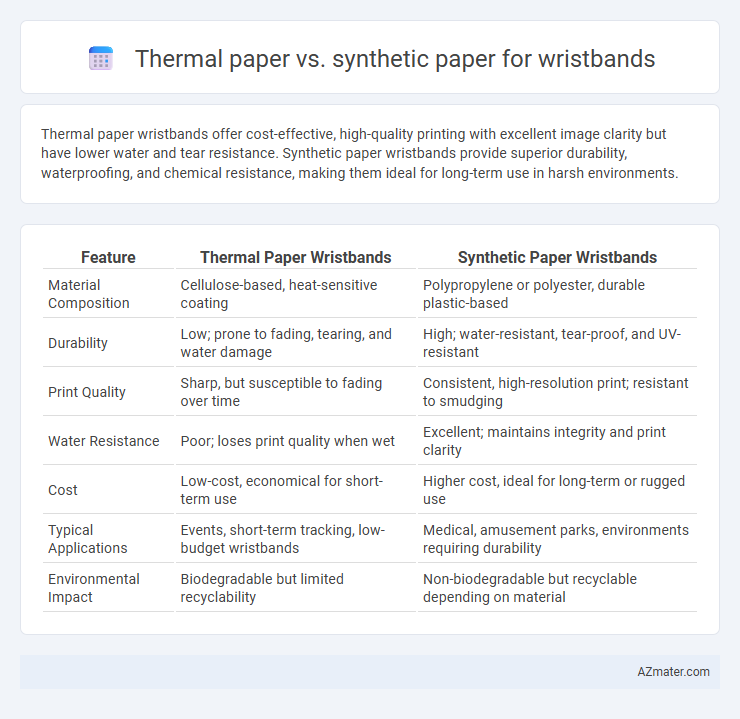Thermal paper wristbands offer cost-effective, high-quality printing with excellent image clarity but have lower water and tear resistance. Synthetic paper wristbands provide superior durability, waterproofing, and chemical resistance, making them ideal for long-term use in harsh environments.
Table of Comparison
| Feature | Thermal Paper Wristbands | Synthetic Paper Wristbands |
|---|---|---|
| Material Composition | Cellulose-based, heat-sensitive coating | Polypropylene or polyester, durable plastic-based |
| Durability | Low; prone to fading, tearing, and water damage | High; water-resistant, tear-proof, and UV-resistant |
| Print Quality | Sharp, but susceptible to fading over time | Consistent, high-resolution print; resistant to smudging |
| Water Resistance | Poor; loses print quality when wet | Excellent; maintains integrity and print clarity |
| Cost | Low-cost, economical for short-term use | Higher cost, ideal for long-term or rugged use |
| Typical Applications | Events, short-term tracking, low-budget wristbands | Medical, amusement parks, environments requiring durability |
| Environmental Impact | Biodegradable but limited recyclability | Non-biodegradable but recyclable depending on material |
Introduction to Wristband Materials
Wristbands are commonly made from thermal paper or synthetic paper, each offering distinct advantages for event management and identification purposes. Thermal paper wristbands provide cost-effective, high-quality printing with clear barcodes and text but may be less durable and water-resistant. Synthetic paper wristbands offer superior durability, water resistance, and tear resistance, making them ideal for extended use or harsh environments where longevity and reliability are critical.
Overview of Thermal Paper Wristbands
Thermal paper wristbands offer a cost-effective and lightweight solution for event access control and healthcare identification, featuring direct thermal printing technology that eliminates the need for ink ribbons. These wristbands provide moderate water resistance and print durability, making them suitable for short-term use in environments where quick and clear barcode or text scanning is essential. Ideal for temporary applications, thermal paper wristbands ensure efficient and accurate tracking without the higher expense and robustness of synthetic alternatives.
Overview of Synthetic Paper Wristbands
Synthetic paper wristbands offer superior durability and resistance to water, tearing, and chemicals compared to thermal paper wristbands, making them ideal for long-term use and harsh environments. Made from plastic-based materials such as polypropylene, they provide enhanced print clarity and vibrant color retention, ensuring important information remains legible throughout an event or process. Their robustness and flexibility support secure fastening and comfort, making synthetic paper wristbands a preferred choice in healthcare, festivals, and industrial applications.
Durability and Lifespan Comparison
Thermal paper wristbands offer high print clarity but have limited durability, typically lasting only a few days before fading or smudging, especially when exposed to moisture or abrasion. Synthetic wristbands, often made from materials like polypropylene or vinyl, provide superior resistance to water, chemicals, and physical wear, extending their lifespan to several weeks or even months. This enhanced durability makes synthetic paper ideal for long-term use in environments requiring strong resilience and legible printing.
Print Quality and Customization
Thermal paper wristbands offer sharp, clear print quality suitable for short-term use but are sensitive to heat and moisture, which can compromise durability. Synthetic paper wristbands provide superior print longevity with resistance to water, chemicals, and abrasion, making them ideal for long-term or outdoor applications. Customization options on synthetic paper are more versatile, supporting vibrant color prints and complex designs that maintain integrity over time.
Water and Chemical Resistance
Thermal paper wristbands have limited water and chemical resistance, often smudging or fading when exposed to moisture or harsh substances. Synthetic paper wristbands offer superior durability, featuring high resistance to water, chemicals, and abrasion, making them ideal for environments requiring long-lasting identification. Their waterproof properties ensure legibility and integrity even after prolonged exposure to liquids and solvents.
Cost Analysis: Thermal vs Synthetic Paper
Thermal paper wristbands typically offer a lower upfront cost compared to synthetic paper, making them a budget-friendly option for short-term events or limited use. Synthetic paper wristbands, although initially more expensive, provide greater durability and resistance to water, tearing, and chemicals, which can reduce replacement costs over time. Analyzing long-term expenses, synthetic paper often proves more cost-effective in environments requiring extended wear or harsh conditions, offsetting its higher initial price.
Environmental Impact and Recyclability
Thermal paper wristbands, commonly used in events and healthcare, are biodegradable but often coated with chemicals that hinder full recyclability and may contribute to environmental pollution. Synthetic paper wristbands, made from plastic materials like polypropylene, offer durability and water resistance but pose significant challenges in recycling due to their non-biodegradable nature and complex production processes. Choosing wristband materials with consideration for lifecycle analysis and waste management infrastructure critically influences environmental impact and sustainability outcomes.
Ideal Use Cases for Each Material
Thermal paper wristbands are ideal for short-term use in events, hospitals, and visitor management due to their cost-effectiveness and quick printability with thermal printers. Synthetic paper wristbands excel in long-term applications such as theme parks, water parks, and outdoor festivals because of their water resistance, durability, and tear resistance. Choosing between thermal and synthetic materials depends on the required lifespan, environmental exposure, and budget constraints of the wristband application.
Choosing the Right Wristband for Your Needs
Thermal paper wristbands offer affordability and clear print quality, ideal for short-term events, while synthetic paper wristbands provide durability, water resistance, and smudge-proof features suitable for long-term or outdoor use. Medical facilities and theme parks often prefer synthetic wristbands for patient safety and reusability, whereas event organizers favor thermal wristbands for efficient mass distribution. Evaluating factors such as duration, exposure to moisture, and required legibility ensures selecting the optimal wristband material to meet specific needs effectively.

Infographic: Thermal paper vs Synthetic paper for Wristband
 azmater.com
azmater.com